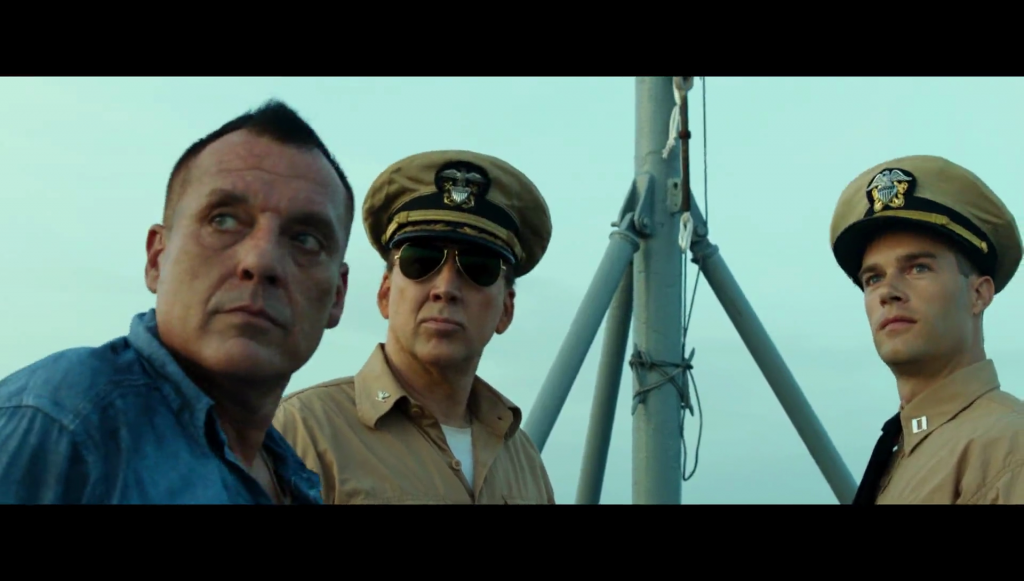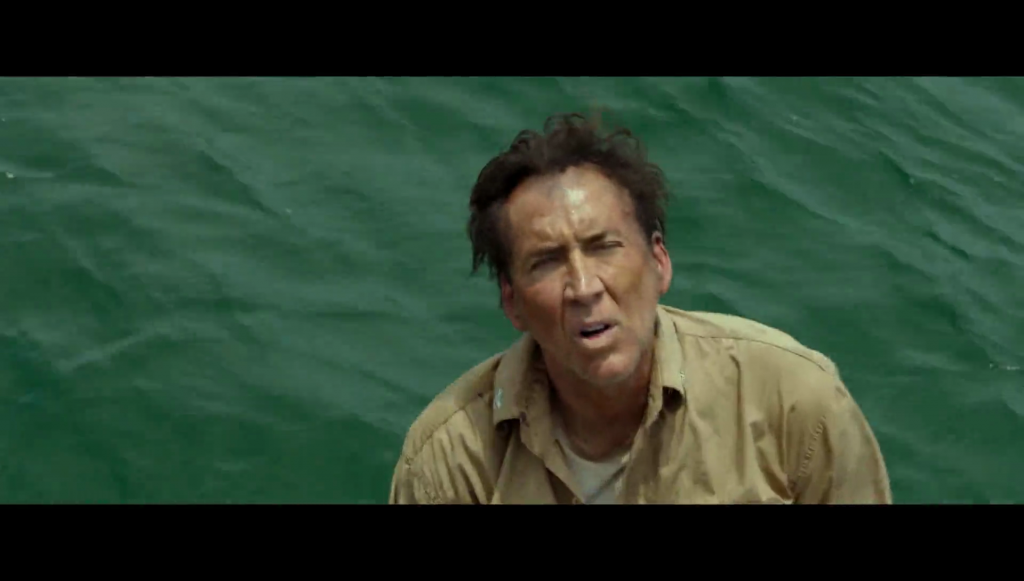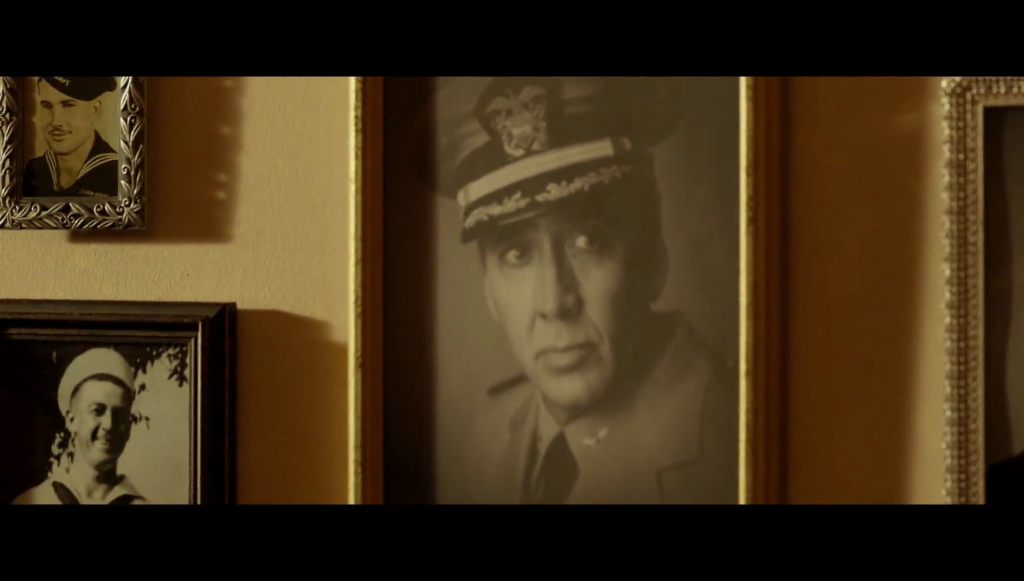Playing the lottery is, generally speaking, an extremely bad way to make money — the statistically expected return is less than £1, for a £2 ticket. But the lottery works as a money-maker for the organisers because even though I rationally understand that, when I started purchasing tickets some particularly deluded part of my brain woke up and started fantasising about what would happen when, not if, I win the lottery.
But I probably will win the lottery, because I’m not just picking any old numbers like some kind of rube: I’m watching every film Nicolas Cage has ever made, and picking numbers based on things that happen in those films. This week, yet another true-life tale of derring-do. Or possibly derring-DON’T.
USS Indianapolis: Men of Courage (2016)
The USS Indianapolis, as it turns out, was the ship that had the fateful duty of delivering the key components of Little Boy, the atomic bomb that was dropped on Hiroshama in the final weeks of World War 2. Only after it did that, it got blown up by Japanese submarine, leaving the surviving crew drifting in the shark-infested Pacific Ocean. All of which, on the face of it, sounds at plausibly like something you could attempt to turn into a film.

And so director Mario Van Peebles (who’s also an actor — he played the bad guy in Highlander 3 which is nice, if like me, you’re morbidly obsessed with the bafflingly improbable longevity of that franchise) has had a go. The problem most war movies have is that inevitably you’re going to end up with a cast of quite literally uniform young men. USS Indianapolis: Men of Courage doesn’t help itself on this front, because a) it expects us to keep track of dozens of them, and b) fails to assign any of them particularly distinguishable personalities.
One character is much easier to keep track of — Captain McVey, played by Nicolas Cage. The material doesn’t allow him to play to his strengths, and he turns a rather stoic, ‘respectful’ performance — there’s a flash of something early on when he writes a letter to his wife, pontificating about the evils of war, before screwing it up and writing something sappy about wanting to see her on his birthday — but that’s about as much playfulness as there’s space for in this Very Serious Movie about Very Serious Events.

At one point in the film, apropos of not very much, the exact latitude and longitude of the ship are displayed on the screen, as though the audience is going to start whooping for the 12th parallel — and this rather gives away what’s really going on. USS Indianapolis isn’t a proper film, it’s military fan-fiction, ploddingly recreating real events and padding them out with some standard movie tropes — got to get home for my best girl, let us overcome differences through adversity, look a shark bit my leg off, and so on.
It’s also got, at best, rather variable production values — any special effect involving a computer is abysmal TV movie stuff. The rest of it hovers around ‘competent if you squint’ but occasionally takes a nosedive, e.g. when someone is seen to reading a magazine titled ‘NATUTAL GEOGRAPHY’ (sic).

Just as you think it’s over, the film takes a hard swerve into courtroom drama for an extended coda in which McVay is court-martialed and convicted by Navy officials covering their own arses, despite the testimony of the Japanese captain responsible for the Indianapolis’s destruction. An important part of the story, but a clumsy way to tell it. Still, it’s the first Nicolas Cage film to end with him shooting himself in the head, so points for that I guess.
THE NUMBERS
4 — One of the basically indistinguishable men has been sweet on his girl ‘since 4th grade’. Awww, or possibly ewww.
5 — The surviving crew of the Indianapolis were rescued 5 days after the ship went down.
7 — “W division was 7 seconds faster”, I have scrawled, for some reason presumably related to this not very interesting film.
13 — The USS Indianapolis was 13 years old when it was sunk, as someone gloomily points out shortly before it gets blown to bits. They should have known, really.
35 — At the time she was sunk, the USS Indianapolis carried the hull number CA-35. CA means ‘heavy cruiser’, for some special military reason I expect.
58 — The Japanese submarine that did for the Indianapolis was the I-58. It’s always a bit bleak when I’m picking the numbers off of real life things that happened, but I suppose I’ve already bottomed out by using 9–11 for that shitty Oliver Stone World Trade Center movie.
THE RESULT
Lottery draw: 2286
Date: Saturday 18 November, 2017
Jackpot: £18,188,218
Draw machine: Guinevere
Ball set: 2
Balls drawn: 1,20,24,36,54,58
Bonus ball: 11
Numbers selected: 4,5,7,13,35,58
Matching balls: 1
Numbers selected (lucky dip): N/A
Matching balls (lucky dip): N/A
Winnings: £0 (£0 to date)
Total Profit/Loss: £-154
1 number.
NEXT TIME, ON WINNING THE LOTTERY WITH NICOLAS CAGE:
Dog Eat Dog, which on the one hand isn’t an earnest portrayal of a real life thing, but on the other hand is written and directed by the same guy who made the fairly poor Dying Of The Light.
Leave a Reply